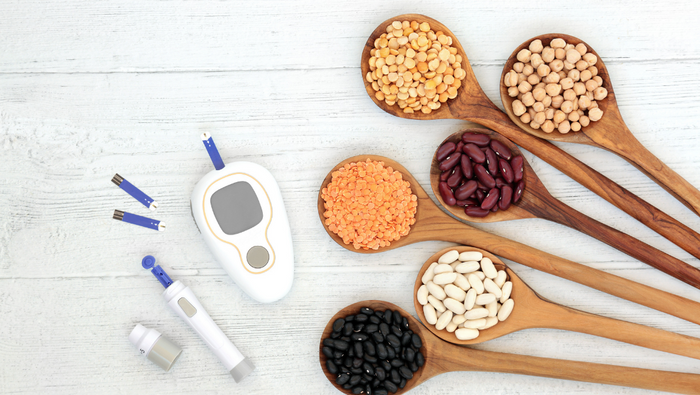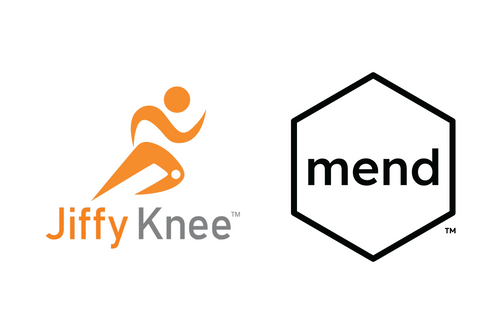Table of Contents
What is blood glucose?What is blood glucose?
In the average healthy individual, the heart pumps approximately 2,000 gallons of blood through the body each day (1). This blood serves to transport oxygen and a variety of different nutrients through the body in order to deliver these nutrients to the necessary target tissues.
One of the substances transported by the blood is glucose (also known as blood sugar). Glucose is a simple sugar that cells can quickly and easily convert to fuel. In this way, blood glucose can be used to power most of the cells in your body, including your brain and your muscles, making this fuel instrumental in the daily life of everyone from scholars to elite athletes.
How does blood glucose work?
Blood glucose is regulated by a combination of what you eat and your energy needs. The main hormones that regulate blood glucose are: glucagon, somatostatin, amylin and insulin (2, 3). All of the aforementioned hormones are produced by the pancreas. Each hormone has their own specific function.Insulin serves to decrease, and glucagon works to increase blood glucose levels (2). Somatostatin works as a regulator, assisting the pancreas in alternating between the production of insulin and glucagon (2). Lastly, amylin serves to increase satiety after a meal (the feeling of fullness). Amylin also assists in decreasing the rate of gastric emptying, which prevents the stomach from emptying too quickly and spiking blood glucose levels (3, 4).
When blood glucose levels are low, which most commonly occurs when individuals have not eaten recently, the pancreas secretes glucagon. This increases the body’s blood glucose levels through glycogenolysis; the process by which glycogen stored in the liver and muscle is broken into glucose (5).
On the contrary, after a carbohydrate-rich meal, blood glucose levels are high due to the exogenous addition of carbohydrates. This increase in blood sugar triggers insulin to be released.Insulin then reduces circulating blood sugar by prompting glucose uptake at insulin-dependent muscle tissue and adipose tissue (6). Thus, while insulin decreases the amount of circulating blood glucose, it puts the glucose to use at target tissues.
In addition to nutritional interventions, exercise can also be a powerful regulator of blood glucose. At the onset of exercise, blood sugar will likely decrease as the body uses the readily available glucose already in circulation (it is a quick and easy fuel source) in combination with endogenous fat stores (7). As the workout continues, blood sugar levels will be dependent upon exercise intensity. Low intensity exercise can use predominantly fat as fuel, stabilizing blood glucose (8). High intensity exercise is predominantly fueled by glucose, as opposed to fat. Thus, sustained high intensity exercise burns through the glucose in circulation then prompts the liver to mobilize stored glycogen as fuel for the working muscles (7).
Why do we care about blood glucose?
High blood sugar is more common than you may think. The American Diabetes Association estimates that 88 million Americans have elevated blood glucose concentrations that rise to the level of prediabetes (9). This is problematic since chronically high levels makes it challenging for cells in your pancreas to make insulin. The pancreas then attempts to compensate for this increased effort by keeping insulin levels elevated. When this pattern repeats over time it damages the pancreas. This damage has the potential to lead to diabetes.
In addition, elevated blood glucose can also induce atherosclerosis, a hardening of the blood vessels (10). As you can imagine, when the vessels transporting blood around the body are damaged, the target tissues are also affected. Thus, downstream effects of atherosclerosis can include increased risk of heart disease, stroke, kidney disease, erectile dysfunction, vision and nerve problems (11).
Monitoring blood glucose is also important for athletes or individuals concerned with sport performance. Blood sugar is an important fuel that plays a role before, during and after exercise.
Before a workout, specifically a sustained high intensity or interval workout, sufficient blood glucose or glycogen stores provide fuel for an optimal performance (8).
During exercise, a sudden and significant drop in blood glucose after prolonged intense exercise can be indicative of usage of all of your circulating glucose and stored glycogen without refueling (12). This phenomenon is commonly referred to a “bonking” or “hitting the wall” and is an undesirable state for any athlete as it is neither pleasant nor conducive to a strong performance (13). When “bonking” occurs the muscle cells will not be able to produce energy (ATP) rapidly enough to maintain high exercise intensity, forcing athletes tofor reduce their pace until they are able to refuel.
After the workout has been completed, blood sugar also plays an important part in recovery (14). Blood glucose levels can assist in muscle building and preparing for the next workout.
How can I manage my blood glucose?
The good news is, your blood glucose levels are highly impacted by lifestyle choices. Consuming high sugar foods in moderation as well as taking part in exercise can help to control blood glucose levels.
The glycemic index (GI) can serve as a starting place for food selection. The glycemic index is a scale (from 1 to 100) used to measure the relative quantity to which specific foods affect blood glucose levels (15). Foods with a high glycemic index (e.g., white bread and potatoes) contain refined sugars that are quickly digested, and so increase blood glucose to the greatest extent. Foods with a low glycemic index (e.g., lentils, milk and carrots) contain complex carbohydrates and are digested more slowly. They assist in the stabilization and maintenance of low blood glucose levels (and do not produce a dramatic spike in blood sugar).
The glycemic index is a helpful guide but it is important to remember that everyone’s physiology is different. There are a lot of foods in the middle range of the glycemic index (defined as a GI rating of 56-69) that could produce high spikes for some individuals while only producing a mild rise for others.
In my experience, a few of those “middle ground” foods are bananas, oatmeal and rice (with glucose spikes heavily dependent upon the type of rice). Adding to the struggle of attempting to eat an entirely low glycemic index diet, there are plenty of foods that provide healthy nutrients that also have a medium to high glycemic index (e.g., dates, some fortified cereals, pumpkin, pineapple, mango, figs, beetroot).
This leaves people with a difficult decision; do they enjoy these foods and their associated nutrients with the understanding that they will have an increased glucose spike or opt to skip these foods?
Adding insult to injury, it is not always convenient or enjoyable to sit at a restaurant and be confined to a salad without croutons and vinegar dressing for the sake of adhering to a low glycemic diet. In these situations, it is helpful to have a tool at the ready to help get your glucose under control.
That tool can come in the form of exercise shortly after eating, which might end poorly if you don’t like moving around with a full stomach.
Whether your goal is to improve your health or fuel your workouts, glucose management is an important component.Exercise and a healthy diet are factors that contribute to the maintenance of blood glucose levels.
References
- Beckerman J. How the Heart Works WebMD2020 [Available from:https://www.webmd.com/heart-disease/guide/how-heart-works#1.
- Woods S, Lutz T, Geary N, Langhans W. Pancreatic signals controlling food intake; insulin, glucagon and amylin. Phil Trans R Soc B. 2006;361:1219-35.
- Vella A, Lee J, Camilleri M, Skarka L, Burton D, Zinsmeister A, et al. Effects of pramlintide, an amylin analogue, on gastric emptying in type 1 and 2 diabetes mellitus. Neurogastroenterology and motility: the official journal of the European Gastrointestinal Motility Society. 2002;14:123-31.
- Moore C, Cooper G. Co-secretion of amylin and insulin from cultured islet B-cells: Modulation by nutrient secretagogues, islet hormones and hypoglycemic agents. Biochem Biophys Res Commun. 1991;179(1):1-9.
- Paredes-Flores M, Mohiuddin S. Biochemistry, Glycogenolysis. Treasure Island, FL: StatPearls Publishing; 2020.
- Roder P, Wu B, Liu Y, Han W. Pancreatic regulation of glucose homeostasis. Exp Mol Med. 2016;48(3):e219.
- Coyle E. Substrate utilization during exercise in active people. Am J Clin Nutr. 1995;61(4):968S-79S.
- Mayo J. Carbohydrate intake for peak performance: practical guidelines for the endurance athlete. AMAA. 2015(Fall/Winter).
- Prevention CfDCa. National Diabetes Statistics Report, 2020. Atlanta, GA; 2020.
- Stout R. Blood glucose and atherosclerosis. Arteriosclerosis. 1981;1:227-34.
- Schiffrin E. Beyond blood pressure: the endothelium and atherosclerosis progression. Am J Hypertens. 2002;15(S5):115S-22S.
- Cermak N, C van Loon LJ. The use of carbohydrates during exercise as an ergogenic aid. Sports Med. 2013;43(11):1139-55.
- Murray B, Rosenbloom C. Fundamentals of glycogen metabolism for coaches and athletes. Nutr Rev. 2018;76(4):243-59.
- Ranchordas M, Dawson J, Russell M. Practical nutritional recovery strategies for elite soccer players when limited time separates repeated matches. J Int Soc Sports Nutr. 2017;14(35):1-14.
- School HM. Glycemic index for 60+ foods: Harvard Health Publishing; 2020 [Available from:https://www.health.harvard.edu/diseases-and-conditions/glycemic-index-and-glycemic-load-for-100-foods.
Colleen Gulick, PhD (ExPhys), MS, BS (BioE), EIT (ME), CSCS, Podium Sports, LLC, Founder CEO



